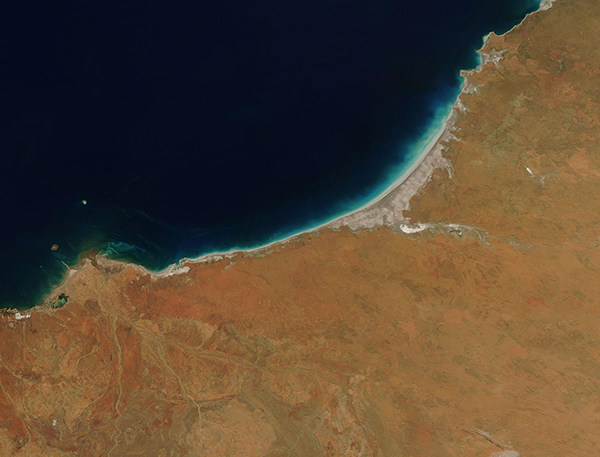Images
October 11, 2022 - Eighty Mile Beach, Western Australia
Tweet
Sitting between the Indian Ocean and the harsh environment of the Great Sandy Desert, a gorgeous bit of beach acts like an oasis, providing a home for abundant wildlife as well an attraction for flocks of tourists each year. According to the Government of Western Australia’s Explore Parks WA website, Eighty Mile Beach is 220 km of uninterrupted white sand, turquoise waters, mudflats, and mangroves that is ideal for anglers, campers, four-wheel drivers, campers, and bird watchers. The unique and important ecosystem is recognized by International BirdLife as an International Bird and Biodiversity Area (IBA) and is recognized as an area of international importance under the Ramsar Convention on Wetlands. More than 400,000 shorebirds rest here on migration and Flatback Turtles—a species found only in Australia—nest on the beach between October and through February.
On October 7, 2022, the Moderate Resolution Imaging Spectroradiometer (MODIS) on board NASA’s Aqua satellite acquired a true-color image of Eighty Mile Beach.
The beach stretches from about Cape Keraudren to Cape Bossut, and actually measures roughly 85 miles (140 km) long. A halo of light blue tints the waters of the Indian Ocean, just off the beach. This is likely caused by sediment washed into the waters by tidal action. A bright white area extending from the Great Sandy Desert (inland) westward to Eighty Mile Beach is the Gascoyne River, a river that holds water roughly 120 days of each year then becomes a dry bed for the remainder of the year.
Image Facts
Satellite:
Aqua
Date Acquired: 10/7/2022
Resolutions:
1km (121.5 KB), 500m (307.5 KB), 250m (157.2 KB)
Bands Used: 1,4,3
Image Credit:
MODIS Land Rapid Response Team, NASA GSFC
Tweet
Sitting between the Indian Ocean and the harsh environment of the Great Sandy Desert, a gorgeous bit of beach acts like an oasis, providing a home for abundant wildlife as well an attraction for flocks of tourists each year. According to the Government of Western Australia’s Explore Parks WA website, Eighty Mile Beach is 220 km of uninterrupted white sand, turquoise waters, mudflats, and mangroves that is ideal for anglers, campers, four-wheel drivers, campers, and bird watchers. The unique and important ecosystem is recognized by International BirdLife as an International Bird and Biodiversity Area (IBA) and is recognized as an area of international importance under the Ramsar Convention on Wetlands. More than 400,000 shorebirds rest here on migration and Flatback Turtles—a species found only in Australia—nest on the beach between October and through February.
On October 7, 2022, the Moderate Resolution Imaging Spectroradiometer (MODIS) on board NASA’s Aqua satellite acquired a true-color image of Eighty Mile Beach.
The beach stretches from about Cape Keraudren to Cape Bossut, and actually measures roughly 85 miles (140 km) long. A halo of light blue tints the waters of the Indian Ocean, just off the beach. This is likely caused by sediment washed into the waters by tidal action. A bright white area extending from the Great Sandy Desert (inland) westward to Eighty Mile Beach is the Gascoyne River, a river that holds water roughly 120 days of each year then becomes a dry bed for the remainder of the year.
Image Facts
Satellite:
Aqua
Date Acquired: 10/7/2022
Resolutions:
1km (121.5 KB), 500m (307.5 KB), 250m (157.2 KB)
Bands Used: 1,4,3
Image Credit:
MODIS Land Rapid Response Team, NASA GSFC




